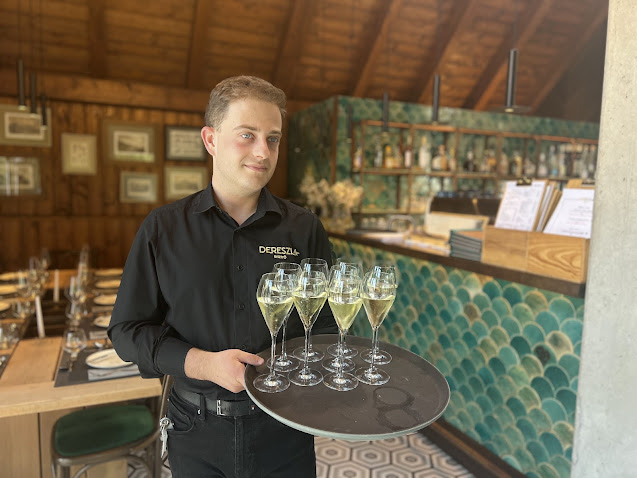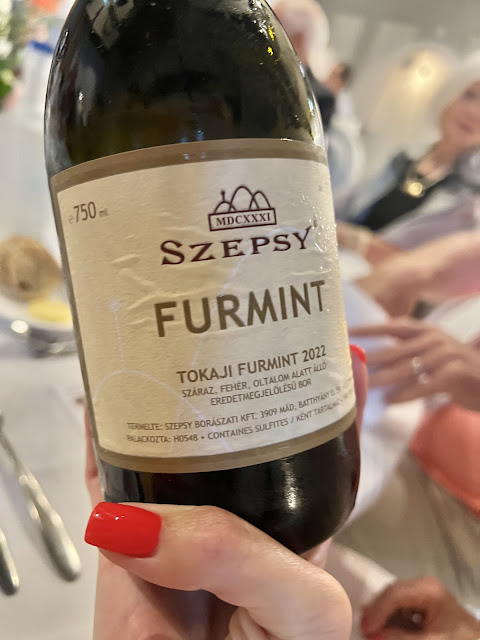Ever since my very first introduction to Tokaj wines I have strived to learn more; so when I visited Tokaj (toe-kye) last May it was, for me, a dream come true. I was so excited to visit the Tokaj wine region for the first time. The Tokaj Wine Region, which takes its name from the town of Tokaj, was established in 1737. It was the first wine region in the world to create an official vineyard classification. While the region is best known for its Tokaji Aszú, a noble sweet wine, it has also received attention for its sparkling and dry white wines.
Federation International of Wine Brotherhoods (FICB) International Wine Tasting and Rating Challenge, Hungary
I had returned to Hungary to attend the 2024 Federation International of Wine Brotherhoods (FICB) International Wine Tasting and Rating Challenge, Hungary 23-28 May 2024. It was hosted this year by Pannonia Wine Sisterhood. The main program was held in Budapest, from May 23-May 26, 2024, followed by the extension program in Tokaj, from May 26-May 28, 2024. After the main program in Budapest off we went to explore and more. Its Furmint wines are produced in a variety of styles, range from bone dry to extremely sweet. It has taken me some time to develop an understanding of Furmint wines from Tokaj. Since 2014 Tokaj's sweet wines have been categorized as Late Harvest, Szamorodni, and Aszú wines. My efforts have including attending Master Classes at Rovinhud Wine Shows, and tasting wines from this wine region during stopovers in Budapest. The result of these earlier efforts I developed insights into Hungary's best known wine region.
Off to Tokaj Wine Country
Our FICB group traveled from Budapest to Tokaj, stopping in Ager. We concluded our day at Tokaj's Wine Research Institute where we received an intro to the region. Next, we met three of Tokaj's female winemakers:
Next day, we participated in the following four activities:
1-2. visit Oremus and Patricius wineries,
3. have lunch with Dereszla wines, and
4. conclude the day with Sezpsy wines, which were introduced by Europe’s 2022 Winemaker of the Year, Ivan Sezpsy.
1. Oremus Winery
We met up with winemaker and was introduced to its fabulous wines. Oremus wine estate in Tolcsva was established in 1993 by the Spanish wine firm, Vega Sicilia owned the Alvarez family. It history dates back to the 1620s.
Today's estate includes historic Tokaji vineyards, with each vineyard characterized by different soil and microclimatic conditions. Besides Furmint they also grow smaller amounts of Hárslevelü, Sárga Muskotály, Zéta, Kövérszolo, and Gohér. The winery utilizes both traditional and contemporary wine production methods. Their botrytized dessert wines (Aszú and Eszencia) undergo a slow fermentation process, and are aged in small barrels in their ancient underground cellars before release. A jewel of the Oremus estate is the ancient, kilometers-long system of cellar labyrinths, which have been protected as a World Heritage Site since 2002. Oremeus is credited with producing the first Tokaji Aszú ever made. Winesearcher notes:
Legend has it that in 1650, fearing an attack by the Turks, harvest was postponed for two months. Grapes were able to dehydrated on the vine and eventually produced an exceptional, intensely sweet wine.
Oremus, Tokaji Aszú 5 Puttonyos 2017 © Spaswinefood
They also produces a single dry Furmint wine called Mandolás.
2. Patricius Winery
I so enjoyed our visit to Patricius Winery, where tradition, values, uniqueness and balance walk hand in hand. It was an awesome experience.
After an introduction to the vineyards, we toured the winery, and concluded with a wine tasting.
Intro to Patricius Vineyards © Spaswinefood
I so loved being introduced to Patricius wines.3. Lunch at Dereszla Bistro
Our introduction to Chateau Dereszla wines was over lunch at Dereszla Bistro. The bistro was a beautiful setting for lunch.
We were welcomed with a glass of sparkling wine.
Château Dereszla, founded in the 15th century, like other Topkaj wineries was nationalized during the communist period. Later the property was privatized in 1991. In 2000 the D’Aulan family from France took over the Estate. They strongly believed that a winery in this historical region was worth being revived again. Their vineyards are eight different locations provides a diversity of perfect conditions for, blending and producing exceptional sweet dessert wines, and high quality dry white wines. They also started production of sparkling wines in 2015.
It was a very enjoyable visit and a great lunch!
4. Dinner with Szepsy Wines
That evening, during our farewell dinner at the hotel, we were introduced to wines from Szepsy Winery. Tokaj's Szepsy Winery has been a family-run winery since at least the 1500s. It is considered one of the emblematic estates of Tokaj.
We were so lucky to spend time with the current winemaker István Szepsy. He is regarded as a master of the region's renowned wine styles.
Over dinner we were introduced to the following three wines:
(1) Szepsy Furmint, Tokaji Furmint 2022
(2) Szepsy Úrágya 63, Tokaji Furmint 2020
(3) Szepsy Szamorodni, Tokaji Édes Szamorodni 2017
YES, Szepsy wines will spoil you!
What a great conclusion to our day it was, with Szepsy wines being introduced by Europe’s 2022 Winemaker of the Year, Ivan Szepsy.
This article resulted from my attending the 2nd FICB Wine Tasting and Rating Challenge in Hungary, 23-28 May 2024. As a member of the KOV (Knights of the Vine) Tahoe Chapter it was a pleasure for me to attend the FICB in Hungary. For sure each visit to Hungary, this was my third time visiting Hungarian wine country, has provided me with the most amazing wine adventures. Moreover, since each of the above activities will be discussed in other posts, at the end this post I will add an earlier article on Tokaj's sweet wines, for which the region is best know.
Now, is also the time explore Hungarian Wines! I invite you to join me in my wine adventures in Hungary at Wine Travels with Dr. Sharon and at Spaswinefood on Twitter and Facebook.
CHEERS!
Understanding Tokaj's sweet side: Late Harvest, Szamorodni, and Aszú wines
 |
| Golden Treasures from Tokaj, Rovinhud 2018 © Spaswinefood |
 |
| Presentation on Tokaj Wines, Rovinhud 2018 © Spaswinefood |
 |
| Late Harvest, Szamorodni, and Aszú Wines © Spaswinefood |
Aszú Wines
It is important to note that since 2014, only the five and six puttonyos wines are permitted to use the term Aszú. Those sweet wines in the three and four category are now labelled Late Harvest, and Szamorodni. In the case of Szamorodni, unlike Aszú wines which are picked by the berry, the grapes are picked in bunches at the end of the harvest, and depending on the sugar level of the grapes are made into dry (Száraz) or sweet (Szamorodni) wines.
 |
| Aszú Berries © Spaswinefood |
Tasting Tokaj 's Sweet Wines
 |
| Lineup of Tokaj Wines © Spaswinefood |
 |
| List of Tokaj Wines © Spaswinefood |
Late Harvest Wines
 |
| Tokaj Late Harvest Wines © Spaswinefood |
1. Barta Prince, Late Harvest Single Vineyard 2017
 |
| Barta Prince, Late Harvest Single Vineyard 2017 © Spaswinefood |
 |
| Royal Tokaji, Late Harvest 2017 © Spaswinefood |
 |
| Disznókő, Late Harvest 2016 © Spaswinefood |
Szamorodni Wines
 |
| Tokaji Szamorodni Wines © Spaswinefood |
The Szamorodni wines poured were:
1. Royal Tokaji, Szamorodni 2016
 |
| Royal Tokaji, Szamorodni 2016 © Spaswinefood |
 |
| Disznókő, Szamorodni 2015 © Spaswinefood |
 |
| Barta Prince, Szamorodni 2013 © Spaswinefood |
The Azsú wines poured were:
1. Royal Tokaji, Aszú 5 Puttonyos 2013
 |
| Royal Tokaji, Aszú 5 Puttonyos 2013 © Spaswinefood |
 |
| Barta Prince, Aszú 6 Puttonyos 2013 © Spaswinefood |
 |
| Disznókő, Aszú 6 Puttonyos 2002 © Spaswinefood |
Just a Little on Tokaj 's Drier Side
I still remember the 2017 Rovinhud Wine Show when I tasted Furmint wines from Barta Prince during a Master Class presented by Barca Károly on Furmint wines. We tasted wines from Barta Winery, Mád, Hungary.
 |
| Barta Winery, Rovinhud Wine Show © Spaswinefood |
 |
| Barta Winery's Eight Wines Tasted © Spaswinefood |
 |
| Furmint Wines, Rovinhud Wine Show 2017 © Spaswinefood |
 |
| Furmint Wines, Rovinhud Wine Show 2017 © Spaswinefood |
Rebirth of Sweet Wines and Birth of Dry Wines
Clearly the Tokaj Wine Region is undergone an amazing rebirth, or a renaissance of its sweet wines, as noted by Ron Wiegand. Perhaps, equally interesting is the birth of its dry wines.
 |
| To Quote Ron Wiegand, MW, MS |
























No comments:
Post a Comment